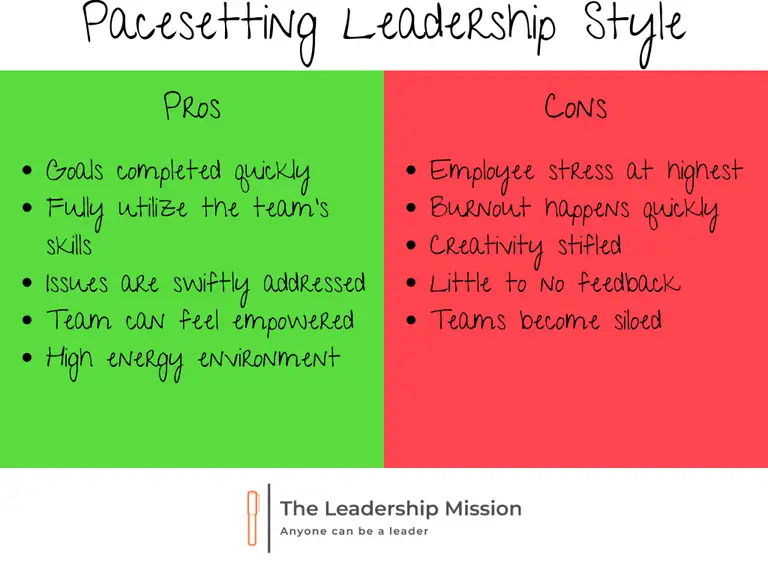Effective leaders can create more effective employees. But how do you adopt a style of leadership that inspires your team but still drives constant improvement? There is a way - it's something called a pacesetting leadership style.
Pacesetting leaders are able to take advantage of different leadership styles to help them reach their goals. They are able to be decisive and organized, while also being able to listen and understand their employees.
They can create reports at great pace. This allows them to build strong relationships with their employees and create a team atmosphere.
What is pacesetting leadership?
This is a leadership style characterized by innovation, creativity, and risk-taking. It is a way of leading that sets the pace for the organization and inspires others to follow.

It is a type of leadership that is often seen as being at the forefront and driving the organization forward. This type of leadership is vital in creating a team that is motivated and able to meet goals.
What are the main elements of pacesetting leadership?
There are four main elements of pacesetting leadership: setting the example, taking a proactive approach, setting high standards, and inspiring others to do their best.
Setting an example
The first element of pacesetting leadership is setting an example. Leaders need to be role models for their team. They need to be examples of how to behave and what to expect. They need to be consistent and have a clear vision.
If leaders set the wrong example, their team will quickly become corrupted. They will stop following the leader's directions and instead start to follow their own interests. They will stop following the vision and goals of the organization.
Taking a proactive approach
Leaders need to take a proactive approach. They need to be proactive in setting the strategy and in leading the team. They need to be proactive in solving problems.
If leaders wait for problems to happen, they will never be able to solve them. They will never be able to get ahead of the competition. They will never be able to achieve their goals.
Setting high standards
Leaders need to set standards that are impossible to achieve, but necessary to achieve the organization's vision and goals.
If leaders set low standards, their team will never be able to achieve anything. They will never be able to reach their goals. They will never be able to change the organization.
Inspiring others to do their best
Leaders need to inspire their team to do their best. They need to motivate them to be the best that they can be.
If leaders don't inspire their team with their pacesetting leadership style, their team members will never be able to achieve their goals or improve.
The disadvantages of pacesetting leadership
It can be difficult to set the right pace. If the pace is too fast, your team may not be able to keep up.
Additionally, setting the wrong pace can lead to burnout. If the team is working too hard, they may not be able to focus on their other tasks.
The benefits of pacesetting leadership
The benefits of the pacesetting leadership style include:
1. It provides clarity of purpose and direction
When a leader sets a clear and consistent vision, it provides clarity to team members and allows them to focus their efforts on achieving a common goal. This type of leadership also helps foster a sense of confidence and trust among team members, which can lead to more productivity and better results.
2. Leads to increased innovation
With encouragement to experiment and take risks, team members are more likely to come up with innovative solutions to problems. This type of leadership also encourages team members to be transparent with their ideas, which can lead to open communication and greater trust.
Besides being able to achieve rapid growth with your skilled team of employees, there is one more advantage. You can decrease employee burnout with the pacesetting leadership style.
3. Initiates a more efficient workflow
Leaders who teach team members to be organized know what is expected of them. They are able to work more productively and efficiently. This type of leadership also helps to avoid duplication of effort and reduces the amount of time needed to complete tasks.
The pacesetting style can increase your level of performance with minimal management from business leaders.
4. Ensures better communication
Team members are able to easily and effectively communicate with one another. They are then able to work more effectively and efficiently. This type of leadership also ensures that all team members are aware of changes and updates, which can help maintain a high level of morale and productivity.
If you're looking into ways of building team morale, this democratic leadership style will make sure everyone communicates more openly with the management team.
5. Leads to a reduction in staff turnover
When team members feel appreciated and have a positive work environment, they are less likely to want to leave the company. This type of leadership also ensures that team members are aware of career opportunities and developments, which can help to retain talented staff.
Out of all styles of leadership, the pacesetting style forces you the most to work on your emotional intelligence. You can decrease the stress levels in your team, build an improved company culture, and a motivated team that is not likely to jump ship soon.

Examples of pacesetting leadership
There are several pacesetting leadership examples that can inspire a team to do their best for their companies.
#1. Inspiring others to be their best
Pacesetting leaders inspire others to be their best. They are always looking for ways to help others reach their full potential, and they are open to new ideas and perspectives. They are confident and assertive, but also respectful and supportive. This combination makes others feel inspired to be their best, and it enables the pacesetting leader to lead by example.
An effective pacesetting leader inspires individual accountability across the entire team by giving them the freedom to do their best work.
#2. Setting high standards
By setting high standards for themselves and for their teams, pacesetting leaders are always looking to improve their skills and to do their best work. They are realistic about the challenges and obstacles that will be encountered, and they are prepared to face them head-on. This attitude sets a strong example for others, and it helps them achieve their goals.
You don't have to be a motivated leader to embrace the pacesetting style - just think realistically about the challenges ahead of you and whether you can meet your higher-level objectives or not.
#3. Encouraging creativity and innovation
Pacesetting leaders are open to new ideas and are willing to experiment in order to find new solutions to problems. They are confident in their own abilities, and they are willing to take risks in order to achieve success. This attitude leads to new ideas and improved products or services, as well as increased team productivity.
#4. Leading by example
You'll always find pacesetting leaders doing their best to set a positive example for others. They are honest and open with their teammates, and they are willing to take on any challenge that comes their way. This attitude motivates others to follow suit and to reach their full potential.
If you see poor performance in your employees, this style of management can bring skilled professionals to reach their peak performance.
#5. Fostering team collaboration
Pacesetting leaders foster team collaboration. They are open to suggestions and ideas from their teammates, and they are always willing to work together in order to achieve a common goal. They trust their teammates, and they are confident in their abilities to lead and work together. This attitude leads to successful teamwork and a high level of productivity.
Pacesetting leadership is a way to set an example for others and motivate them to achieve the same goals. It is also a way to ensure that the company's mission and values are upheld. Ultimately, you can drive increased job satisfaction and employee engagement with this visionary leadership style.
Wrapping up
Becoming a pacesetter leader can be amazing for your short-term goals as well as the overall future of your company. This style of leadership can bring benefits to your department and improve the standard of performance for all of your employees.
And perhaps the best way to get started is to find out where your time is going. Try Unrubble today and start tracking your time with one click - entirely free!







